
Around Bandai-san
Goshi-ki-numa, the Five-Colored Lakes
I had flown from Chicago to Seattle and then
on to Tōkyō, staying just two nights there,
one full day.
Then I had come north to the Tōhoku region
by train.
My first full day there was expected to be clear and sunny,
but the next day would probably be dark with rain.
So, on my first full day in Aizu-Wakamatsu I went to see the
Five-Colored Lakes.
As with "Aizu-Wakamatsu" versus "Aizuwakamatsu",
or "Nanuka-machi-dori" versus "Nanukamachi dori"
and so on, the name for the lakes is divided various ways.
Maybe Go-shiki-numa or maybe Goshikinuma
or possibly Goshiki-numa.
However you spell it, the name refers to
several lakes and ponds
in at least five different colors.
Five colors, many more than five lakes and ponds.
The chain of lakes is on the north slopes of Mount Bandai,
known locally as Bandai-san,
within one of the three large sections of
Bandai-Asahi National Park.
Mount Bandai is marked with its peak elevation of 5968 feet on this 1963 aeronautical chart. It erupted in 1888, destroying dozens of villages, killing hundreds of people, damming streams and creating hundreds of small lakes and ponds. Bandai hasn't erupted lava for about 10,000 years, this was a large explosion of water vapor that distributed ash with varying mineral content over the surrounding terrain.
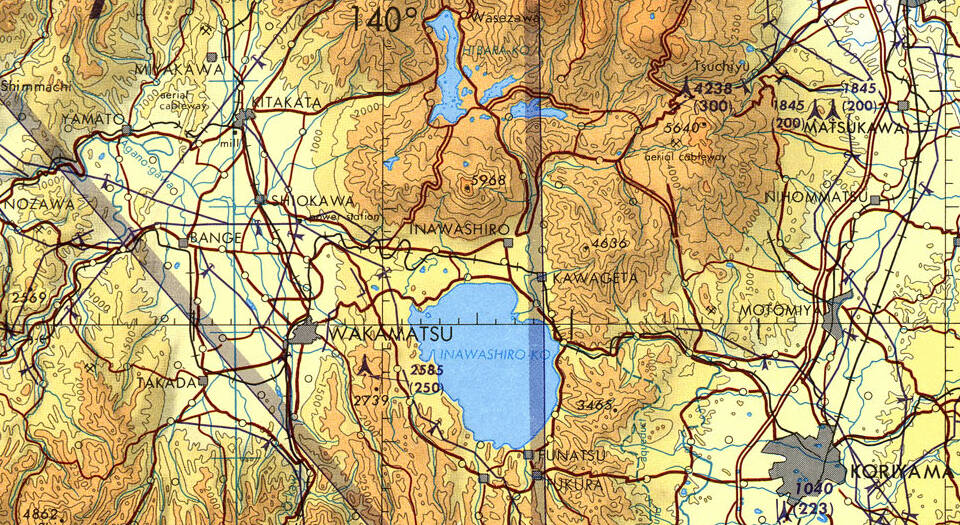
Small portion of 1:500,000 Tactical Pilotage Chart TPC G-11B, from the Perry Castañeda Library Map Collection at the University of Texas. Aizu-Wakamatsu is labeled simply "Wakamatsu" to the left of the large Lake Inawashiro near center. I took the train from there to Inawashiro Station. Then, a bus on the road marked in red counter-clockwise around Mount Bandai. The west end of the trail is near the south end of Lake Hibara, north of the volcanic mountain.
Lake Inawashiro was also formed by eruptions from Mount Bandai. Some 30–40,000 years ago a major eruption and pyroclastic flow formed a dam across a depression. Now it's the fourth-largest lake in Japan, covering 104 square kilometers. The water level was significantly lower during the Jōmon period of roughly 14,000–300 BCE. Distinctive Jōmon artifacts have been found in now-submerged sites near the lake's shoreline. The Jōmon people created cord-marked pottery. The Ainu people largely living in Hokkaido today are probably descended from the Jōmon. The rest of today's Japanese people arrived later from the Asian mainland.
To Inawashiro By Train, By Bus To The Trail
My innkeeper had helped me annotate the train and bus schedules I had picked up at the Tourist Information Office. I would first travel to Inawashiro by train, on the Banetsu West Line. The train station is pretty quiet outside of skiing season.
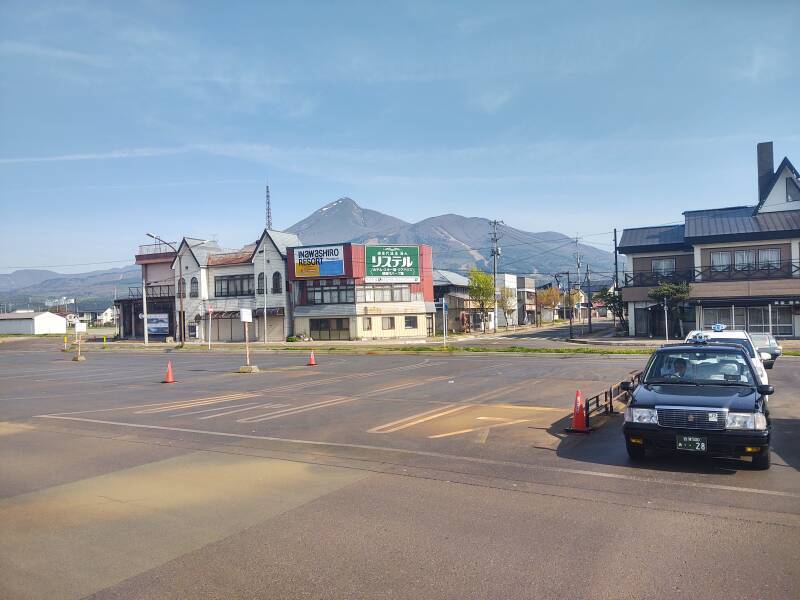
Mount Bandai, visible in the distance above, is considered to still be an active volcano. It is thought to have first formed from eruptions around 290,000 years ago. It's a stratovolcano, with a steep conical shape formed from relatively viscous lava. A shield volcano forms from much more liquid lava, which spreads further and results in a lower profile.
The last lava flow from Mount Bandai is thought to have happened around 10,000 years ago. Bandai's activity since then has been limited to water vapor, sometimes leading to collapse and avalanche. That's what happened in 1888, when a week of rumbling and earthquakes was followed by a series of violent explosions.
Sulfur mining used to dominate the local economy, but the last sulfur mine closed in 1968. Now Inawashiro relies on tourism and agriculture. The tourism includes several ski areas and onsen or hot springs with bathing facilities, plus people like me on their way to and from the Five-Colored Lakes. The local agriculture is largely buckwheat and rice, along with tomatoes, dairy, and soybeans to be fermented into miso. Miso has been produced here since the Jōmon period of roughly 14,000–300 BCE.
The highest peak of Mount Bandai has been re-measured, because the triangulation point installed in 1904 disappeared due to erosion. Now the main peak is officially 1,816.29 meters, with several other peaks including Akahani at 1,430 meters and Kushigamine at 1,636 meters created during the 1888 eruption.
Shugendō atMount Haguro
The ruins of the Enichi-ji Buddhist temple are at the base of the southwest slope of Mount Bandai. You pass close to Enichi-ji on the train between Aizu-Wakamatsu and Inawashiro. Enichi-ji was founded in 807 CE, one year after a major eruption. It was possibly founded because of that eruption. There have been forms of mountain worship in Japan since literally pre-historic times, some of which continues today as Shugendō. There are pilgrimage routes from Enichi-ji to the peaks of Mount Bandai and the nearby Mount Mayadake and Mount Azuma.
My bus arrived after a short wait. Precisely on time, of course.

You board a Japanese bus at the rear, taking a ticket from the machine next to the door. You pay as you get off at the front, with the fare based on how far you rode.
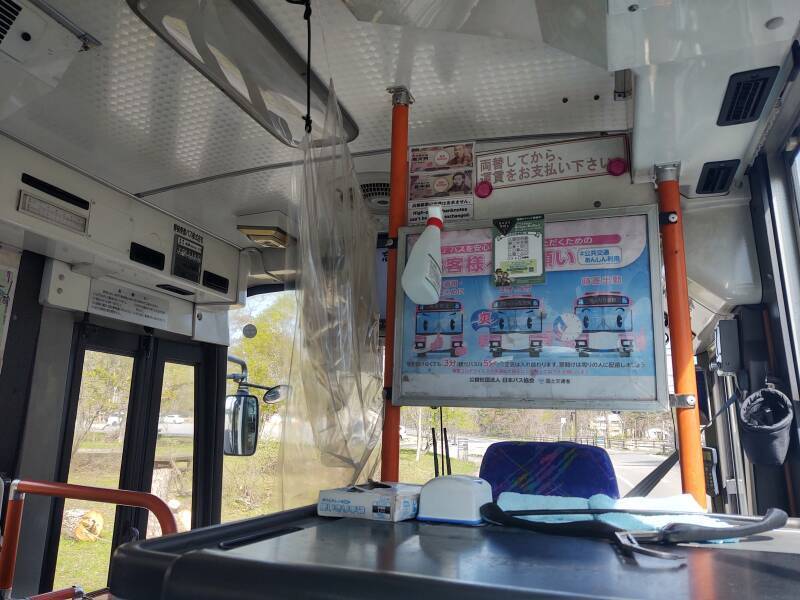
I rode the bus around the north side of Bandai-san to the Urabandai Kogen Eki bus stop.
Goshi-ki-numa, the Five-Colored Lakes
The west end of the Five-Colored Lakes path is across from the Urabandai Kogen Eki bus stop at Yanagi-numa Pond. My innkeeper had recommended walking from west to east. That's the best direction for walking it end-to-end.
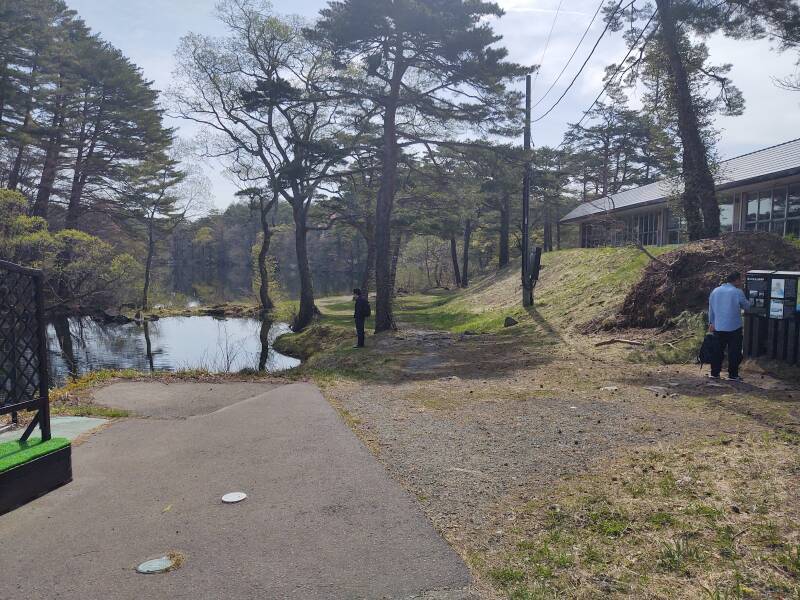
Mount Bandai's last violent eruption, on July 15, 1888, is believed to have been preceded by a long period of hot ground water eroding parts of the mountain. There had been audible rumbling for a week, but it wasn't recognized as a warning of an imminent eruption. Earthquakes began at 0700, and the first steam explosion occurred at 0745, followed by roughly 20 more explosions. The north side of Bandai underwent sector collapse. Lahars or heated mudslides and avalanches of debris buried five villages in this area, killing 477 people.
Those volcanic mudslides and avalanches buried and completely reformed this area, creating the numerous small lakes and ponds.
The varying mineral deposits and specific algae varieties lead to the range of colors, from a reddish green to a cobalt blue. Or at least that's the English description in my references.
English speakers say that "blue" and "green" are two distinct colors specified by those names.
Speakers of Japanese, like many other languages, certainly perceive the differences between the colors but use a single term for the entire range. That's why older pedestrian and traffic signals still look rather blue to English-speaking visitors, although to the local drivers and pedestrians they are obviously "green for go". Modern Japanese has the word midori for the narrow range called "green" in English, but it's only used in certain situations. Japanese speakers have exactly the same color perception as anyone else, it's just that they describe things differently. This isn't some visual confirmation of the Sapir-Whorf hypothesis. (which, as the variant Sapir-Worf hypothesis, would explain why neither Buddhist nor Christian scriptures could be accurately translated into the invented Klingon language)
Maybe the problem is that English speakers are too vague. Speakers of Greek and Russian would inform you that the supposed English colors "deep blue" and "light blue" are in fact two entirely distinct colors with different names.
| Greek | Russian |
| μπλε | синий |
| γαλάζιος | голубой |
English follows Greek and Russian in distinguishing "red" and "pink" as two colors, while they're really the same hue at different saturations and intensities. So why does English lump the above two into "blue"?
| English | Greek | Russian |
| red | κόκκινος | красный |
| pink | ροζ | розовый |
Speaking of color, Yanagi-numa Pond is home to some koi, colorful varieties of the Amur carp originating with fish breeders in Niigata in the early 1800s.
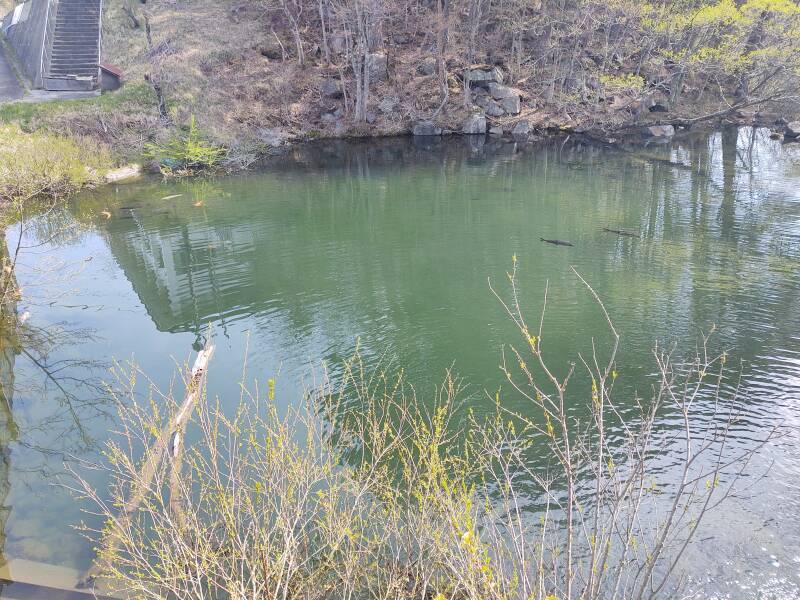
Lighting also changes the apparent color. If you are walking the trail from west to east in the morning, you may perceive less color when looking toward the sun. Make sure to turn to look across and look back at the bodies of water.

This is part of Bandai-Asahi National Park, Japan's third-largest national park. It's divided into three separate units, this is its Bandaiazuma-Inawashiro Region.
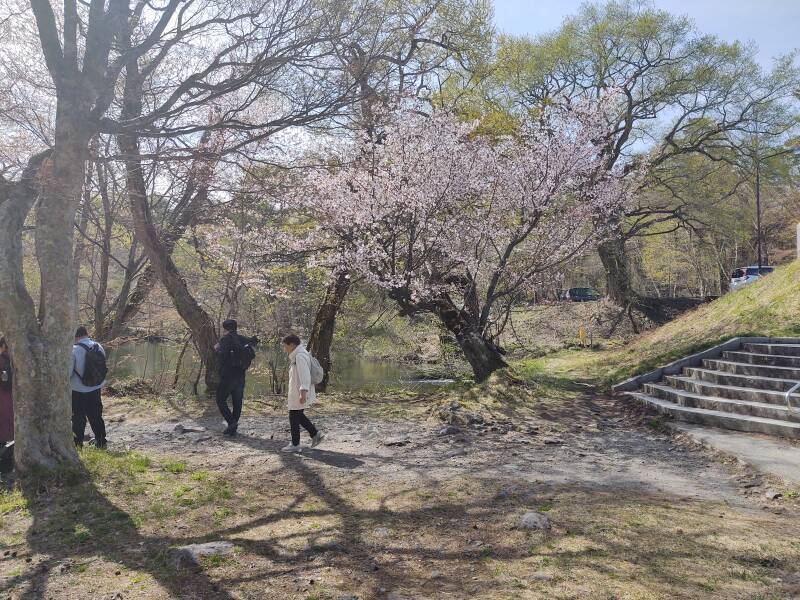
To the northwest is the Dewasanzan-asahi Region with the Three Mountains of Dewa — Mount Haguro, Mount Yudono, and Mount Gassan. They're a holy area for the Shugendō mountain worship religion, with ascetic hermits who practice their strict doctrine on the mountains. They're also popular with visitors like me, later in this trip.

Note to self: Bring bear bells the next time.
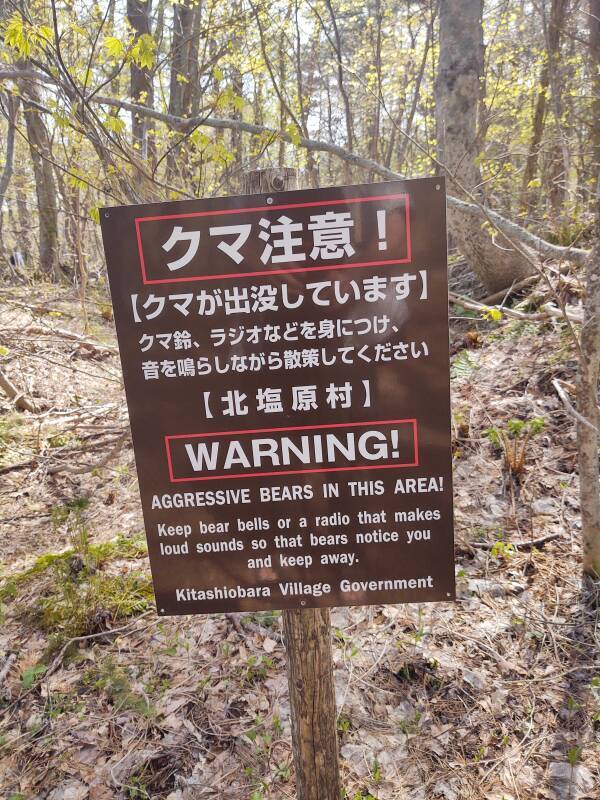
A side path branches off to north from the main trail, a short distance east of Yanagi-numa Pond. It leads to a Buddhist memorial at 37.650759° N, 140.069870° E.
Further note to self: Remind any bears to behave with Buddhist compassion and loving-kindness.


A short stele stands at the center of a clearing. A large eroded stone shelters a smaller stele and a wee statue.
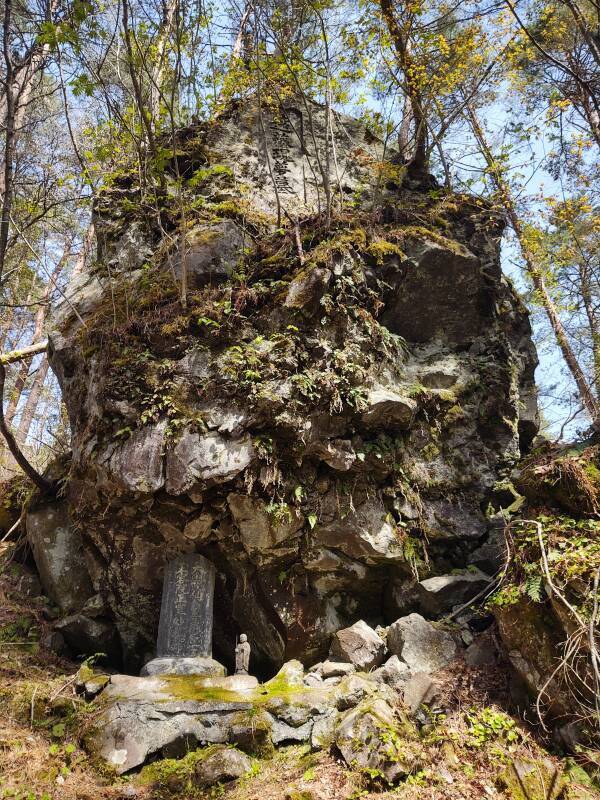
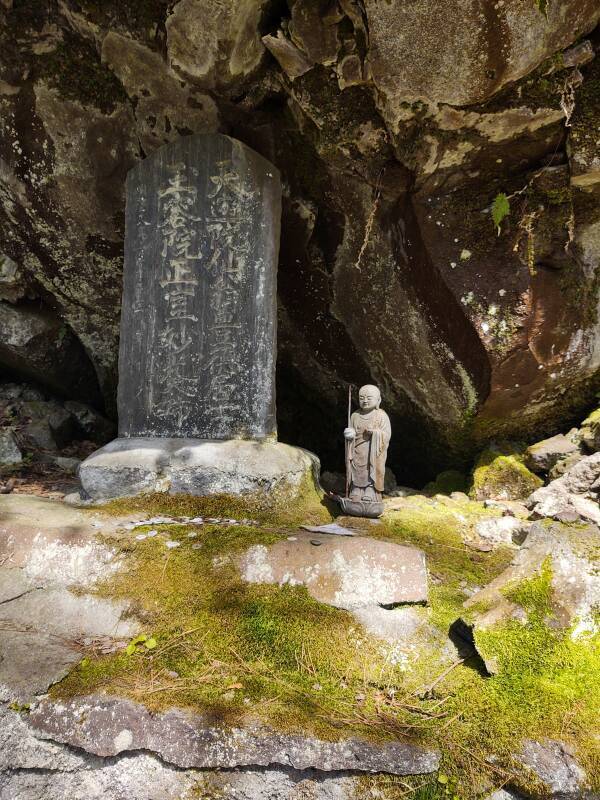
Ao-numa pond reminded me of copper sulfate solutions from chemistry class.
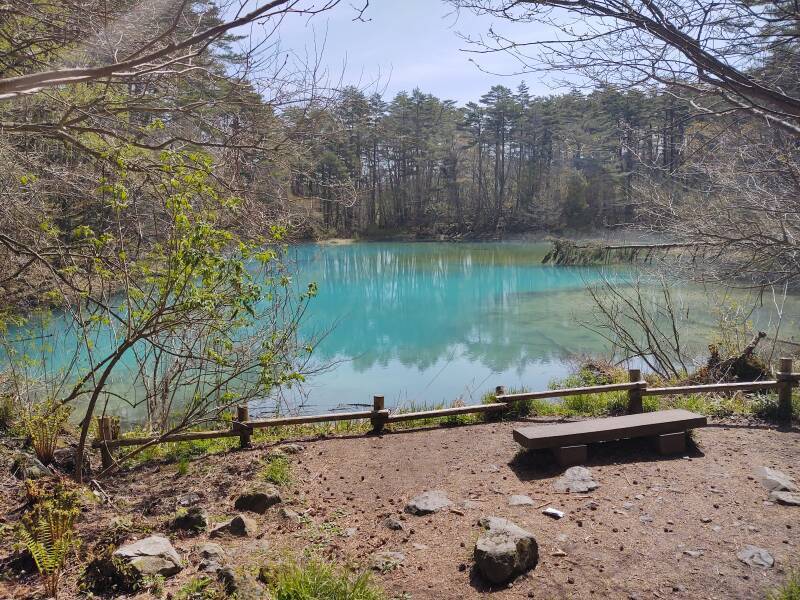
Very CuSO4.
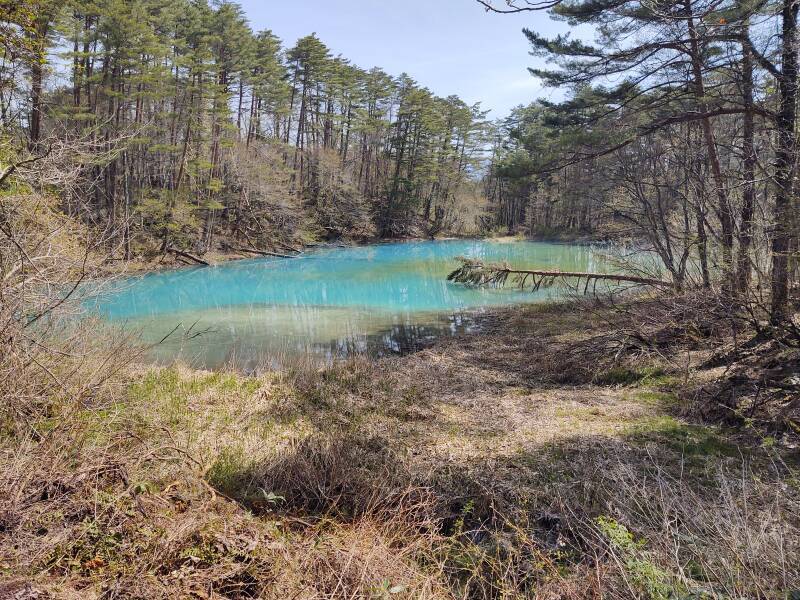

Ruri-numa pond is on the south side of the trail, looking toward the north face of Mount Bandai. As seen back at the Inawashiro Station, its southern face had a relatively smooth conical surface. But its north face is where the 1888 explosive eruption and its following lahars and avalanches created three peaks and irregular terrain.
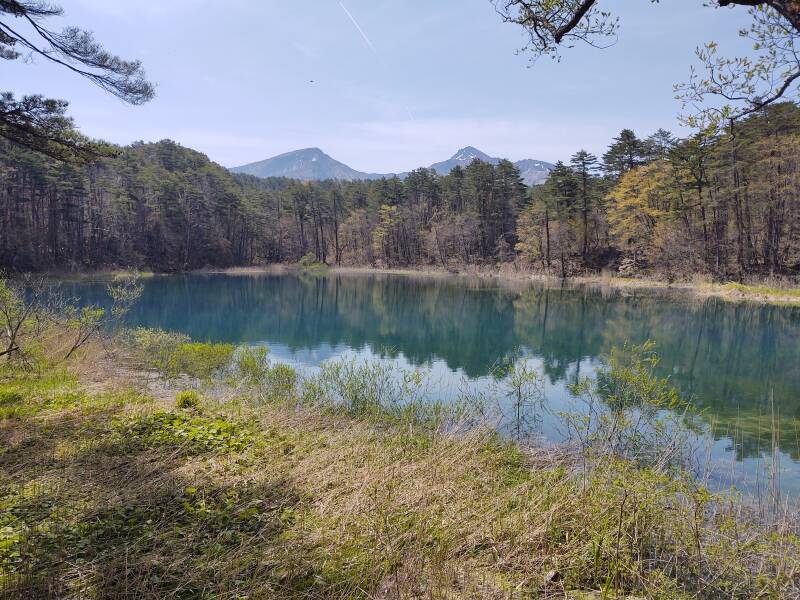
A sign at a viewing platform at Ruri-numa pond depicted アマビエ or あまびえ or amabie, a Japanese supernatural cryptid. The flier is from Japan's Ministry of Health, Labour, and Welfare, and it urges people to take steps to control the COVID-19 pandemic. It has been further embellished with an amabie sticker.

The legends say that Amabie emerges from the sea, or from smaller bodies of water, to prophesy an abundant harvest, or an epidemic, or both. Likenesses of Amabie are thought to defend against illness. Amabie and Akabeko obviously need to team up, once we figure out how to get a three-legged mermaid to ride a red cow.
Amabie is a mermaid, or sometimes a merman, with a mouth like a bird's beak and three legs or tail-fins. Japanese folklore seems to include several supernatural figures with extra legs, like Yatagarasu the three-legged crow. The name may come from "Amabiko", which for reasons of language development also appears as "Amahiko".
Woodblock print bulletins and pamphlets are known from the 1840s. Here's one from an Edo-era newspaper of Kōka 3, or 1846 CE, which looks like it's the source of the above sign:
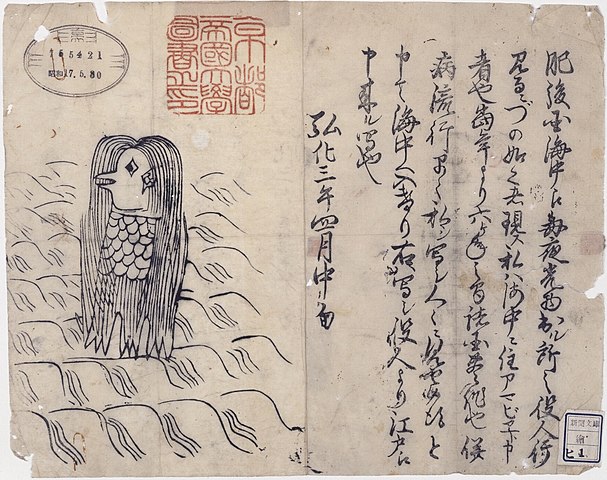
A legend reports that around the middle of the fourth month of the year Kōka-3, or in mid-May 1846 CE, a glowing object had been seen almost every night in the sea off Higo Province, today's Kumamoto Prefecture, on the west coast of Kyūshū. A town official went to the shore to investigate, and encountered a creature who introduced herself as Amabie, who lived in the open sea. She delivered a prophecy:
Good harvest will continue for six years from the current year. If disease spreads, draw a picture of me and show the picture of me to those who fall ill.
Then Amabie returned to the sea. The town official made a sketch of the creature, and then his sketch and story spread across Japan in the kawaraban or woodblock-printed news bulletins.
There were four reports of appearances in Higo Province; one in Hyūga Province on the east coast of Kyūshū, and one in Echigo Province a short distance northwest from here on the Sea of Japan coast around today's Niigata. Some reports were vague as to location, and others carefully specified names of villages or counties that turn out to be fictitious.
Amabie may appear in a smaller body of water. The Tōkyō Nichinichi Shinbun newspaper reported in 1875 that Amahiko-no-mikoto or "His Highness Heaven Prince" was seen in a rice paddy in Yuzawa, in today's Niigata Prefecture, in 1875. The newspaper story included a crude illustration of a four-legged creature that resembled a doll or an ape.
Benten-numa pond was the next lake. Below is the view to the north across Benten-numa toward other nearby mountains. Mount Nishi-Daiten and Mount Nishi-Azumayama are the two peaks with high snow-covered areas. Mount Yanabe is the slightly lower and closer multi-peak mountain to their left.
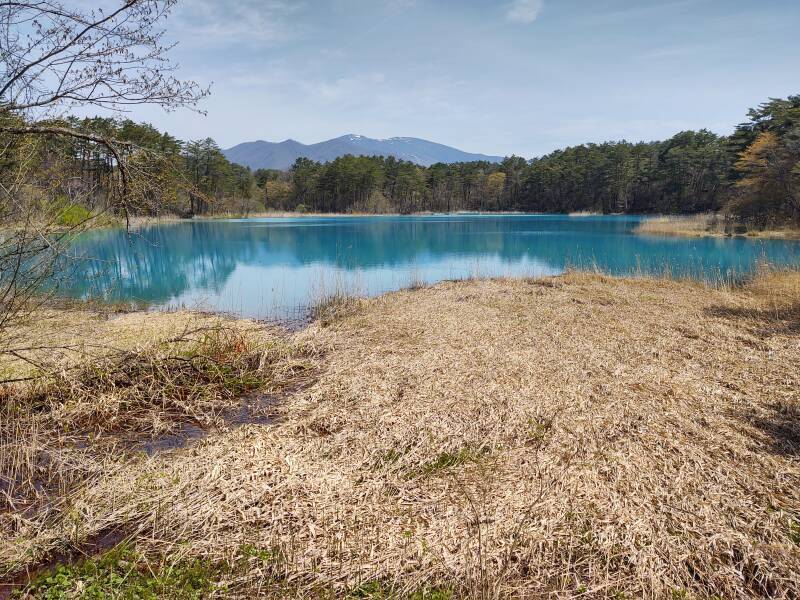
The above view to the north gives Benten-numa a slightly greenish shade of blue. The view to the west, below, is more green with some yellowish areas.

Tatsu-numa pond is smaller and very green.

Midoro-numa pond is even more green. Google Translate suggests that みどろ ぬま literally means "green swamp", or at least みどり ぬま or midori numa would.

Aka-numa pond is also very green.
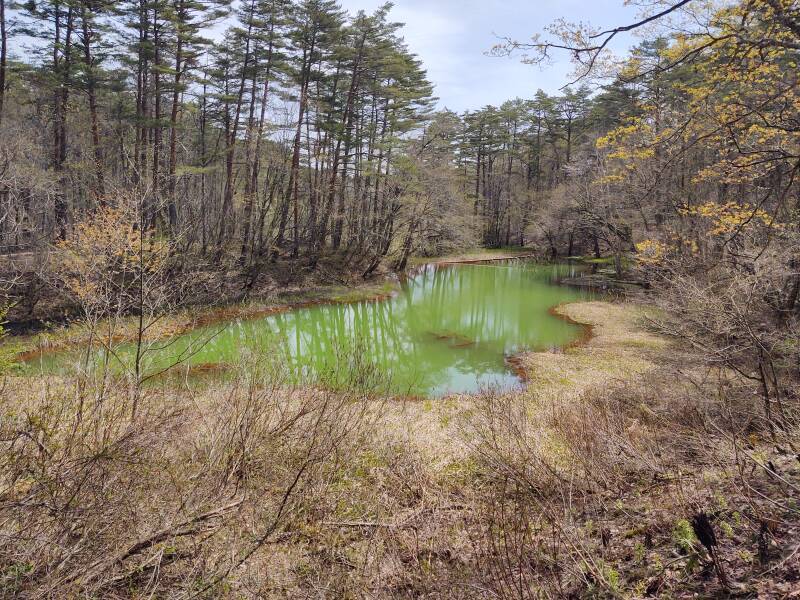
This stream connects Aka-numa to Bishamon-numa.
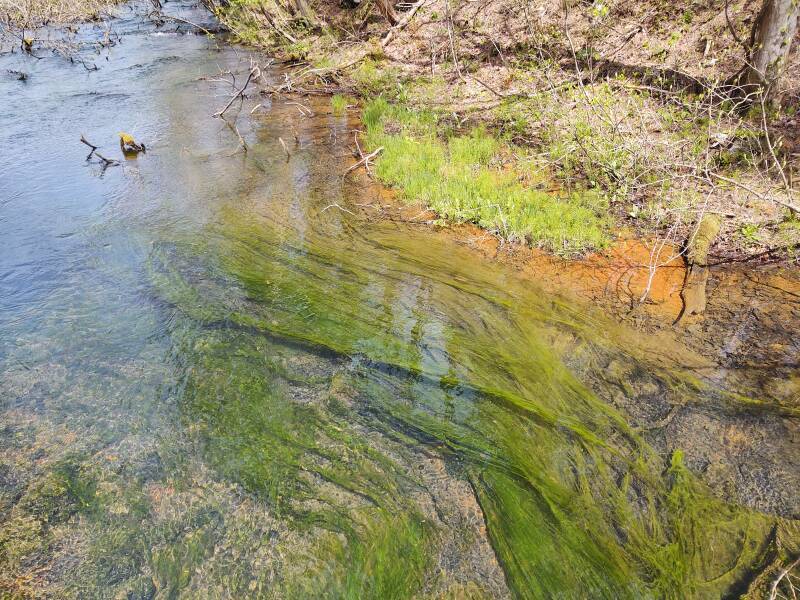
Bishamon-numa is the largest of these lakes.
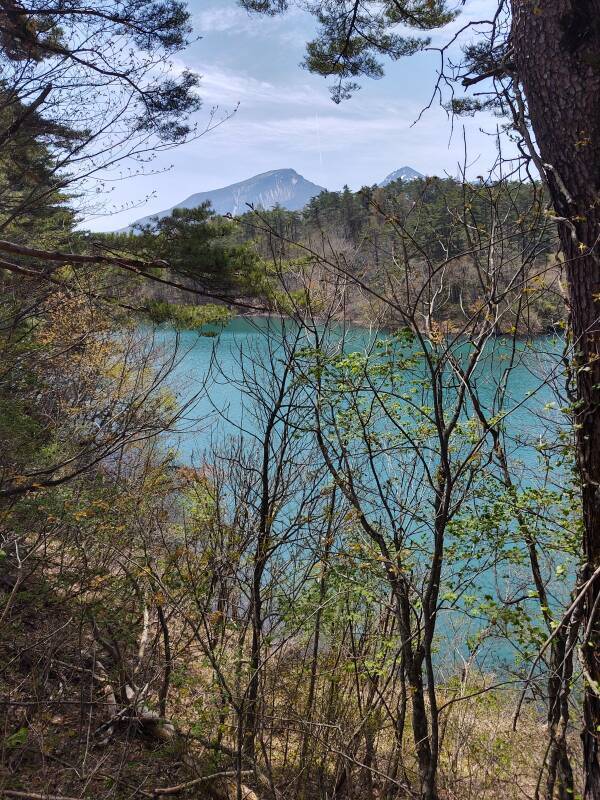
Those are the rough peaks of Bandai-san as seen from the north. You can rent a boat and get close to the koi.
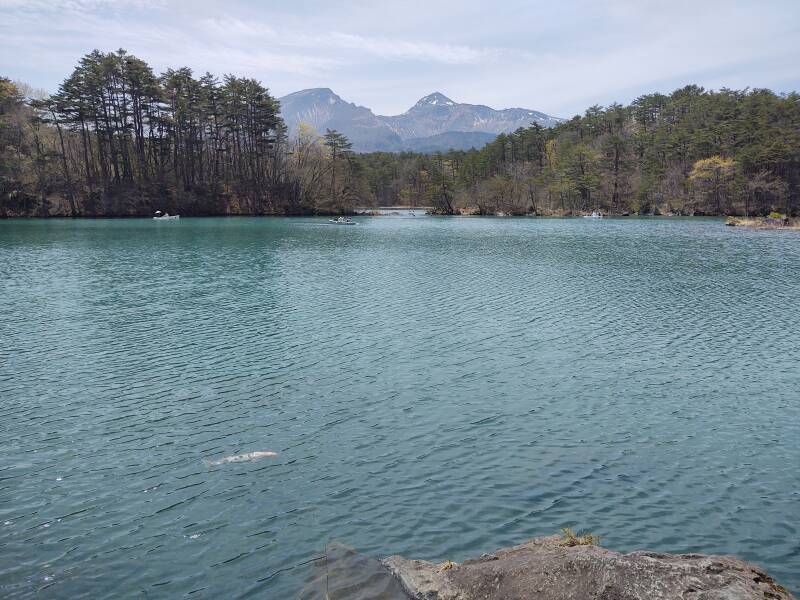
The east end of the trail took me to the village of Kitashiobara. It has a population under 3,000, and is home to some hotels for visitors to the ski areas and onsen.
A national park facility provided some background on the volcano and the lakes, along with a stuffed bear. I bought lunch at a nearby convenience store.
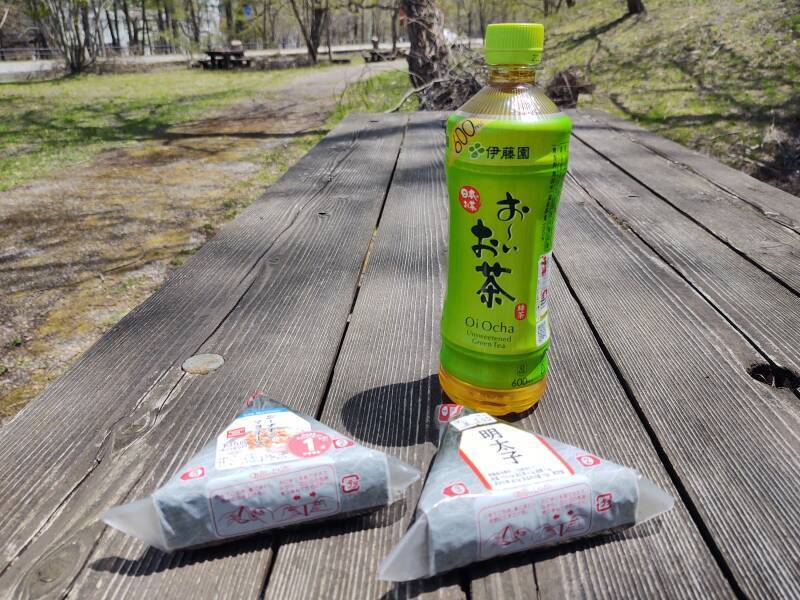
Visiting the Morohashi Museum of Modern Art
Teizo Morohashi founded Sankyo, a men's clothing retailer now known as Xebio Holdings with headquarters in Kōriyama. It has over 100 stores across Japan, largely specializing in clothing for golf and other sports.
MorohashiMuseum of
Modern Art
He became interested in, and then began collecting, the art of Salvador Dalí. He then built this museum, preserving and exhibiting over 340 items by Dalí, the world's fourth-largest Dalí collection. It also has works by Impressionist, Post-Impressionist, and Cubist artists.
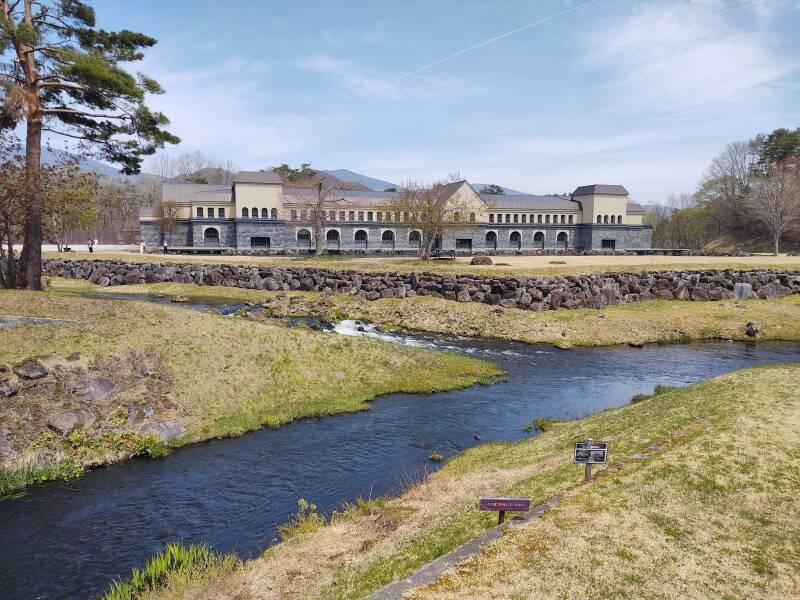
Morohashi chose a design that evokes a medieval stable, built with the local slate. The main exhibition hall is a space about 100 meters long running along the side overlooking the pond. It displays the large 4×3 meter Battle of Tetouan painting plus many sculptures. The parallel series of rooms behind the main hall houses a series of short-term special exhibits.
The Dalí collection focuses on bronze cast sculptures. I much prefer his detailed paintings which are extremely realistic renderings of surreal scenes. He really understood optics!
Check in advance, the entire museum was closed for about seven months over the winter of 2022-2023, and closes periodically to set up a new exhibit.
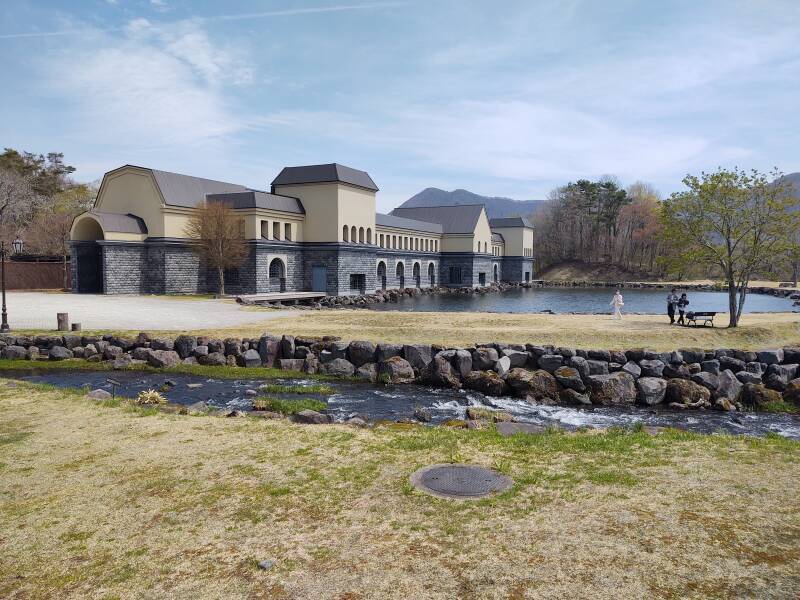
Returning From Inawashiro to Aizu-Wakamatsu By Train
There was a bus stop along the road in front of the Morohashi Museum, and from there it was a short ride to Inawashiro Station.
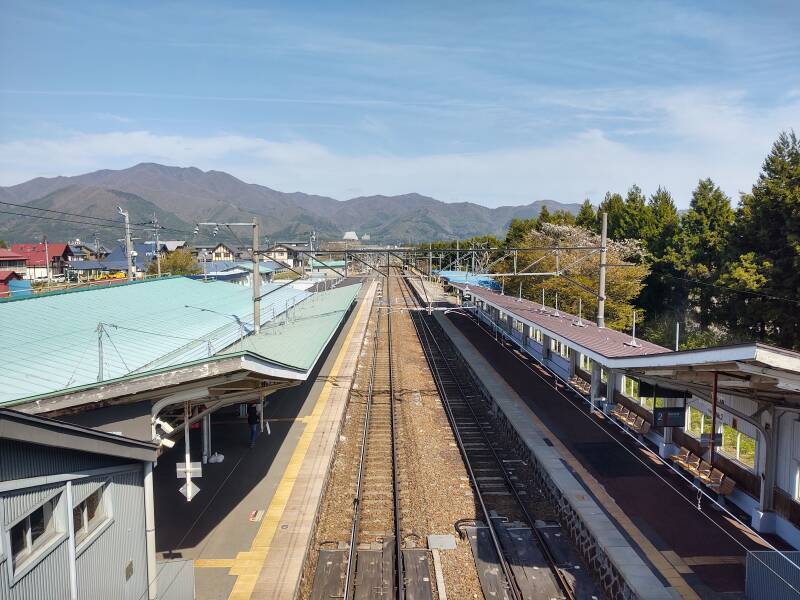
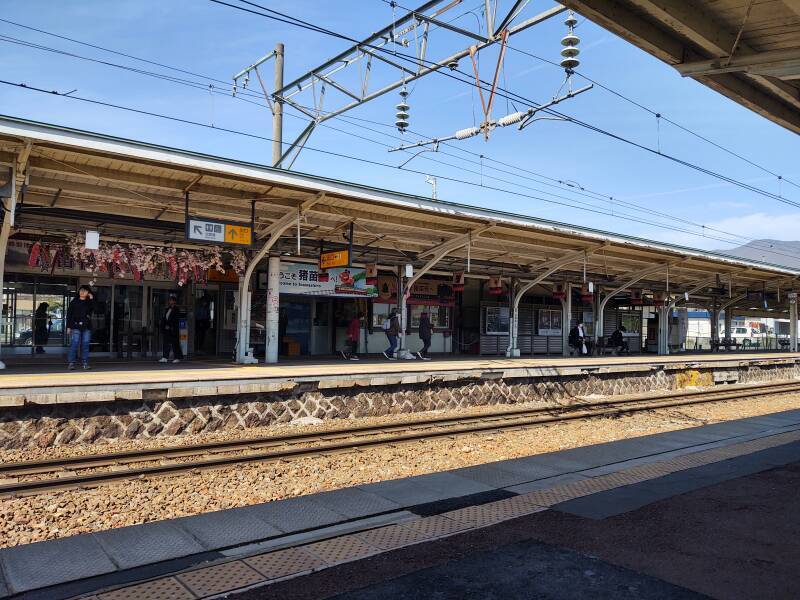
Inawashiro was the birthplace of Hideyo Noguchi, you will see pictures of him at the station.
He invented syphilis!
No...
Oh, he discovered syphilis!
No, it has obvious symptoms and there's evidence that it infected people in the Americas around 10,000 years ago and in Greece around 580–250 CE. People definitely knew about it, although they didn't distinguish it from other diseases including leprosy.
That is, he discovered what
causes syphilis!
Well, sort of. Europeans understood it to be a sexually transmitted disease by 1500 CE, and people in east Asia and the Americas probably understood that much earlier.
Ah, then Hideyo Noguchi figured out that the Spirochaeta pallida bacterium, now known as Treponema pallidum, is the pathogen that causes syphilis!
Yes, that's what he did.
His discovery put him on the ¥ 1,000 note in 2004. That's the smallest bank note in a country where cash transactions remain quite common, so you tend to walk around with a fistful of Noguchi.

In 2024 he would be replaced on the ¥ 1,000 note with a different Japanese bacteriologist, Kitasato Shibasaburō, who co-discovered in 1894 that Yersina pestis is the infectious agent that causes bubonic plague, and four years later, that the Shigella bacteria causes dysentery. The back of that note replaces Mount Fuji with Hokusai's Great Wave off Kanagawa.
Hideyo Noguchi fell into a fireplace when he was just one and a half years old, severely burning his left hand. After he entered elementary school, his teacher and the families of schoolmates paid for surgery that restored about 70% of the function in that hand. He decided to become a physician, and apprenticed himself to the surgeon who had repaired his hand.
Medical employers in Japan worried that his hand deformity would repel potential patients, so he concentrated on medical research. He graduated from a proprietary medical school and then had a brief internship at the Kitasato Institute in Tōkyō. In 1899 he met Simon Flexner, a professor of pathology at the University of Pennsylvania in Philadelphia who was traveling with a medical group from the U.S. Flexner encouraged Noguchi to study in the U.S., and in 1901, Noguchi arrived in Philadelphia. He initially worked on snake venom, and later on infectious diseases.
The Rockefeller Institute of Medical Research opened in 1910 in New York City, and the two men moved their research programs to there. The facility was on Randall's Island, in the East River between Manhattan and Queens. Noguchi began working to develop a skin test for syphilis.
It was a strange time for medicine and public health. The Royal Society for the Prevention of Cruelty to Animals was founded in England and Wales in 1824. Another 60 years passed before the UK founded the National Society for the Prevention of Cruelty to Children in 1884. The U.S. was on a slightly faster track but still took care of the animals first, having founded the American Society for the Prevention of Cruelty to Animals in 1866 and the American Society for the Prevention of Cruelty to Children in 1875.
Vivisection was a big concern. Various anti-vivisection groups were organized, and they were opposed to any use of animals in medical research. The fear was that any use of animal test subjects would immediately lead to vivisection of humans. And with names like the "National Anti-Vivisection Society", founded in the U.K. in 1875, who was going to object — it would be like saying "Oh, come on, where's the harm in a little vivisection?"
H. G. Welles wrote his 1896 novel The Island of Doctor Moreau during this time of public worry about vivisection. The 1996 movie is the best known today, but the 1932 Island of Lost Souls is the superior film adaptation. Pre-Code! With Bela Lugosi! Although it lacks Val Kilmer's character mocking Marlon Brando's character, and Marlon Brando mocking, well, Marlon Brando.
In 1911, Noguchi began developing a syphilis skin test similar to the tuberculin skin test. The experiments involved injecting a syphilis antigen then called luetin under the skin of the subject's upper arm.
His study at the Rockefeller Institute involved 571 subjects. 315 of them were known to have syphilis, and the remaining 256 were "control" subjects who did not have syphilis. Some of the controls were hospital patients already under treatment for other infectious diseases including leprosy, pneumonia, tuberculosis, and malaria. The other control subjects were orphans.
Hideyo Noguchi's Luetin Experiment and the AntivivisectionistsAnti-vivisectionist groups learned about the project and began protesting. New York was home to two such societies, the Vivisection Investigation League and the New York Anti-Vivisection Society. They said that Noguchi was violating the rights of orphans and hospital patients, and risked infecting the orphans with syphilis.
The Institute explained that Noguchi and his fellow researchers had tested the extract on themselves before administering it to any subjects. The process involved heating the antigen to a temperature above 60 °C for an hour and putting it in a 0.5% phenol solution, neither of which the bacillus could survive. Also, some of the supposed control subjects were found to be infected, allowing them to secure medical treatment.
None of that calmed the anti-vivisectionists, who continued to promote a water cure for rabies, homeopathy, and other nonsense, while sending hate mail to researchers and hospitals.
In 1913 Noguchi found Treponema pallidum in the brain of a patient with progressive paralysis caused by meningoencephalitis associated with syphilis, showing that the bacterium was the cause.
Complicating matters, that same year Noguchi was diagnosed with untreated syphilis, for which he refused treatment from Rockefeller Hospital.
In 1918, Noguchi traveled throughout Central and South American with the International Health Board, conducting research to develop a vaccine against yellow fever, and researching Oroya fever, poliomyelitis, and trachoma.
His work began to be criticized for inaccuracies in the 1920s. Other researchers were unable to reproduce many of his results, including his claimed discoveries of the pathogens causing rabies, yellow fever, polio, and trachoma. He had confused yellow fever with leptospirosis, and while his purported yellow fever vaccine was effective, it was effective against leptospirosis. After the British pathologist Adrian Stokes died of yellow fever in 1927, it was becoming obvious that the disease was caused by a virus, not by the Leptospira icteroides bacillus, as Noguchi believed.
Noguchi worried that his reputation was at stake, and went to Lagos, Nigeria, to carry out further research. However, he found that the working conditions there did not suit him.
William Alexander Young invited him to move to the British Medical Research Institute in Accra, Gold Coast, today's Ghana, and Noguchi moved there in 1927.
Within a year, Young was finding that Noguchi was a very difficult guest researcher. He was ill-tempered and secretive, and worked almost entirely at night to avoid contact with co-workers. One of his fellow researchers described his behavior as erratic and bordering on the paranoid, and his methods as haphazard. He had inoculated a huge number of monkeys with yellow fever without keeping proper records. He repeatedly failed to keep infected mosquitoes contained within specially designed secure containers. Since he had inoculated himself with a vaccine of his own development, he may have believed himself to be immune to yellow fever. However, that was the vaccine that was actually effective against leptospirosis.
Neurosyphilis and H.P. Lovecraft's fatherNoguchi's increasingly erratic behavior may have been caused by the untreated syphilis that he had been diagnosed with in 1913 having progressed to neurosyphilis.
In May 1928, having failed to find evidence for his theories, but at least without infecting all of his co-workers with yellow fever, Noguchi prepared to return to New York. He returned to Lagos and boarded a trans-Atlantic ship, but then he fell seriously ill and the ship diverted to put him ashore back in Accra. He was taken to a hospital, and diagnosed with yellow fever.
Nine days later, Hideyo Noguchi died of yellow fever. And just seven days after that, despite thorough sterilization of the British Medical Research Institute, and especially Noguchi's laboratory, Young also died of yellow fever.
Since the late 20th century, Noguchi's development of his syphilis test has been considered an early example of unethical human experimentation.
Confederate "hero" James Marion Sims and his human vivisection projectFar worse things were done, but the anti-vivisectionists were primarily concerned about threats to white people. The Confederate "hero" James Marion Sims developed gynecological surgical procedures through experimental operations performed without anesthesia on enslaved women. He operated on one woman 30 times. A statue honoring him is in the lawn of the Alabama capitol building in Montgomery.
Then there was the U.S. government's Tuskegee Experiment that studied but did not treat 399 Black men infected with syphilis from 1932 to 1972. And the U.S.-led syphilis experiments in Guatemala in 1946–1948, when physicians infected 1,300 people with venereal diseases without their informed consent, and only treated 700 of them.
Out of the grim medical history and onto the train...

Soon the two-car single-staff train arrived to take me back to Aizu-Wakamatsu.
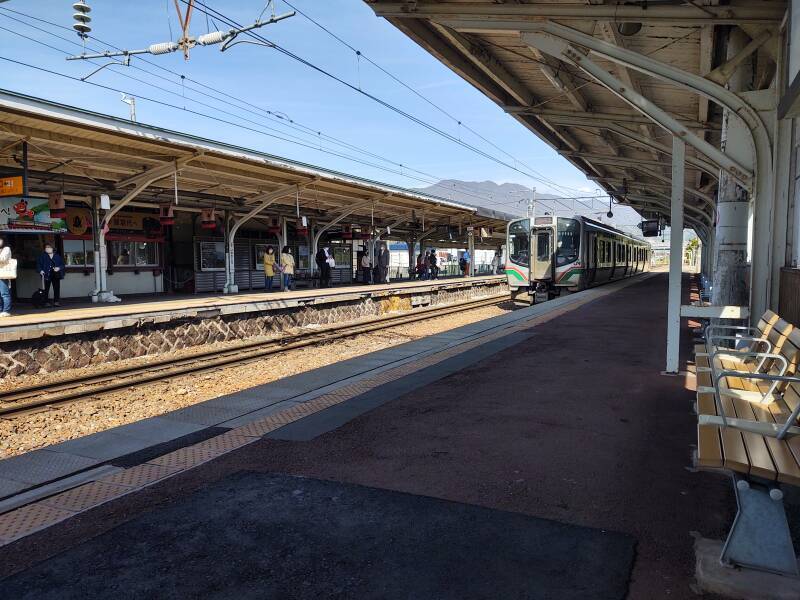
The next page in this series explores Aizu-Wakamatsu, visiting its Shōgunate-period castle and exploring more recent history.
Next❯ Aizu-Wakamatsu's Castle and Other History
Other topics in Japan:






































As in the kana ヒ or ひ for hi serving as the base for ビ or び for bi and ピ or ぴ for pi.